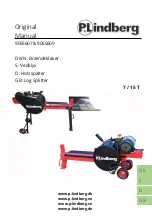
11
WARNING: Use extreme care when
handling gasoline. Gasoline is extremely
flammable and the vapors are explosive.
Never fuel machine indoors or while the
engine is hot or running.
Starting Engine
•
Attach spark plug wire to spark plug. Make certain
the metal cap on the end of the spark plug is
fastened securely over the metal tip on the spark
plug.
•
Engines with choke lever:
Move choke lever on engine to CHOKE position. (A
warm engine may not require choking).
•
Engines with primer:
Prime engine as instructed in separate engine
manual.
•
The throttle control lever is located on the engine.
Move engine throttle control lever to FAST or
START position.
•
Grasp starter handle and pull rope out slowly until
engine reaches start of compression cycle (rope
will pull slightly harder at this point).
•
Pull rope with a rapid, continuous, full arm stroke.
Keep a firm grip on starter handle. Let rope rewind
slowly.
•
Repeat the previous steps until engine fires. When
engine starts, move choke control (if equipped)
gradually to RUN position.
•
If weather is cold, run wedge up or down beam 6 to
8 times to circulate the hydraulic fluid.
WARNING: When starting a warm engine,
the muffle and surrounding areas are hot
and can cause a burn. Do not touch.
Always:
•
Use clean fluid and check fluid level regularly.
•
Use Dexron III Automatic Transmission Fluid or
10W AW hydraulic fluid.
•
Use a filter (clean or replace regularly)
•
Use a breather cap on fluid reservoir.
•
Make certain pump is mounted and aligned
properly.
•
Use a flexible “spider” type coupling between
engine and pump drive shafts.
•
Keep hoses clear and unblocked.
•
Bleed air out of hoses before operating.
•
Flush and clean hydraulic system before starting
after any malfunction or servicing.
•
Use “pipe dope” on all hydraulic fittings.
•
Allow time for warm-up before splitting wood.
•
Prime the pump before initial start-up by turning
over the engine with spark plug disconnected.
•
Split wood with the grain (lengthwise) only.
Never:
•
Use when fluid is below 20° F or above 150° F.
•
Use a solid engine /pump coupling.
•
Operate through relief valve for more than several
seconds.
•
Attempt to adjust unloading or relief valve settings
without pressure gauges.
•
Operate with air in hydraulic system.
•
Use teflon tape on hydraulic fittings.
•
Attempt to cut wood across the grain.
Using The Log Splitter
•
Place the log splitter on level, dry, and solid ground.
•
Place the beam in either the horizontal or vertical
position and lock in place with the appropriate
locking rod.
•
Block the front and back of both wheels.
•
Place the log against the end plate and only split
wood in the direction of the grain.
•
When necessary to stabilize the log, place your
hand only on sides of log. NEVER place hand on
the end between the log and splitting wedge.
•
Only one adult should stabilize the log and operate
the control handle, so the operator has full control
over stabilizing the log and movement of the
splitting wedge.
WARNING: Wear leather work gloves,
safety shoes, and safety glasses when
operating log splitter. Ensure safe footing.
Control Handle Positions
•
Move control handle FORWARD or DOWN to split
wood.
•
Release the control handle to stop the wedge
movement.
•
Move control handle BACK or UP to return the
wedge.
Vertical Position
•
Pull the horizontal beam lock out and pivot it down
to release the beam. Pivot the beam to the vertical
position.
•
To lock the beam in the vertical position, pull out on
the vertical beam lock and pivot it to secure the
beam. See Figure 14.
•
Stand in front of the log splitter to operate the
control handle and to stabilize the log.
Horizontal Position
•
Pull the vertical beam lock out and pivot it down.
Pivot the beam to the horizontal position.
•
To lock the beam in the horizontal position, pull out
on the horizontal beam lock and pivot it to secure
the beam. See Figure 15.
•
Stand behind the reservoir tank to operate the
control handle and to stabilize the log.
Summary of Contents for 24AD595C190
Page 17: ...17 Notes ...

























